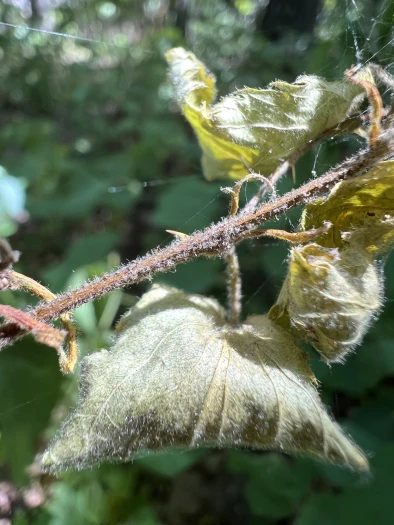Highbush Blackberry
(Rubus alumnus)
Highbush Blackberry (Rubus alumnus)
/
/

Nathan Aaron
CC BY 4.0
Image By:
Nathan Aaron
Recorded By:
Copyright:
CC BY 4.0
Copyright Notice:
Photo by: Nathan Aaron | License Type: CC BY 4.0 | License URL: http://creativecommons.org/licenses/by/4.0/ | Rights Holder: Nathan Aaron | Publisher: iNaturalist | Date Created: 2022-07-26T19:45:29Z |










Estimated Native Range
Climate Requirements for Seoul, Korea, Republic Of
| This Plant | Your Site | Plant Suitability for Your Location | ||
|---|---|---|---|---|
| • Precipitation | 26" - 57" | 53" | Aquatic | Aquatic |
| • High Temp. | 71°F - 93°F | 85°F | Your summer temperatures are normal for this plant. | Excellent |
| • Low Temp. | -10°F - 34°F | 20°F | Your winter temperatures are normal for this plant | Excellent |
This plant may not grow well at your location - your precipitation is too high.
Summary
Rubus alumnus, commonly known as the Highbush Blackberry, is a deciduous shrub native to a variety of habitats including open woodlands, forest edges, and riparian areas across eastern and central North America. It typically grows to a height of 5-6 feet (1.5-1.8 meters) with an equal spread, featuring arching canes and compound leaves with toothed leaflets. The plant produces clusters of white to pale pink flowers in late spring to early summer, which are moderately showy and attract pollinators. Following the flowering season, the shrub bears edible blackberries that are attractive to both humans and wildlife.
The Highbush Blackberry is valued for its fruit production and is used for both culinary and wildlife habitat purposes. It is often found in home gardens, naturalized areas, and as part of restoration projects. This species prefers well-drained soils, tolerates a range of soil types, and is best grown in full sun to part shade. While it requires regular moisture, it is relatively drought-tolerant once established. Gardeners should be aware that the plant can spread aggressively via root suckers, potentially becoming invasive in some areas. Pruning is recommended to maintain a tidy appearance and to promote fruiting.CC BY-SA 4.0
The Highbush Blackberry is valued for its fruit production and is used for both culinary and wildlife habitat purposes. It is often found in home gardens, naturalized areas, and as part of restoration projects. This species prefers well-drained soils, tolerates a range of soil types, and is best grown in full sun to part shade. While it requires regular moisture, it is relatively drought-tolerant once established. Gardeners should be aware that the plant can spread aggressively via root suckers, potentially becoming invasive in some areas. Pruning is recommended to maintain a tidy appearance and to promote fruiting.CC BY-SA 4.0
Plant Description
- Plant Type: Shrubs
- Height: 3-5 feet
- Width: 4-6 feet
- Growth Rate: Rapid
- Flower Color: White
- Flowering Season: Spring, Summer
- Leaf Retention: Deciduous
Growth Requirements
- Sun: Full Sun, Part Shade
- Water: Medium
- Drainage: Fast, Medium, Slow
Common Uses
Bird Garden, Butterfly Garden, Edible*Disclaimer: Easyscape's listed plant edibility is for informational use. Always verify the safety and proper identification of any plant before consumption.
Natural Habitat
Open woodlands, forest edges, and riparian areas
Other Names
Common Names: Oldfield Blackberry
Scientific Names: Rubus alumnus , Rubus apianus , Rubus barbarus , Rubus campester , Rubus corei , Rubus corei , Rubus facetus , Rubus fernaldianus , Rubus impos , Rubus independens
GBIF Accepted Name: Rubus alumnus